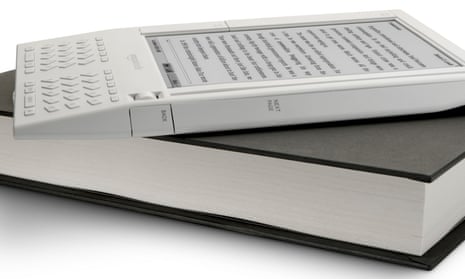George W Bush was in the White House, Chris Brown was topping the Billboard chart and Jeff Bezos … well, on 19 November 2007, Jeff Bezos was doing “the most important thing we’ve ever done” and launching the Amazon Kindle.
The first Kindles were chunky things about the same size as a paperback, weighing a smidgeon less than 300g. They had wonky little keyboards and a little wheel for scrolling up and down a grey and black screen. But Bezos was never aiming for a flashy design. Speaking at the launch in New York, he said that all he wanted was a device that could “disappear”.
“All of us readers know that flow state when we read,” Bezos explained. “We don’t think about the glue, the paper, the stitching – all of that goes away. All that remains is the author’s world, and we flow right into that.”
But the Kindle was never only a device for reading, it was also a device for selling books. As the messy business of glue, paper and stitching faded away, there on your grey and black screen was a bookshop already primed with details of your credit card.
“Instead of shopping on your PC,” Bezos explained, “you shop on the device … And guess what? [Books] are all $9.99. And guess what? They all get delivered wirelessly in less than minute.”
No more schlepping to a bookshop, or – imagine – a library. No more waiting for the post. A direct connection from electronic page to electronic shop made bookbuying a seamless part of the reading experience.
And it worked. According to the American Association of Publishers, ebook sales leapt from $20m in 2006 to $53.5m in 2008, the first full year of the Kindle era, and are now worth about $1bn (£756m) a year. Here in the UK, Nielsen suggests that digital books now make up around a quarter of the market.
But the Kindle was never only a portable bookshop, it was also a publishing house. Strip away the expensive business of jackets, paper and physical distribution, and the words of a Booker winner or a Nobel laureate appear much like those of anyone else. According to bibliographic company Bowker, the number of books self-published in all formats in the US rose from around 80,000 in 2006 to a staggering 800,000 last year. And that’s not counting the 43% of authors self-publishing on Amazon who do so without bothering to get an ISBN. It’s difficult to get any hard data on what’s happening within the Amazon jungle, but some estimates suggest that as many as two thirds of US adult fiction sales are digital and almost half are released without the input of a traditional publisher – with the all-conquering Kindle accounting for 80% of English-language ebook sales.
The publishing market has changed beyond recognition over the last decade, but what about the reading experience in the Kindle age? Are you up past midnight, diving into the next novel of some series after buying it with just one click? Are you out exploring the vast self-published world beyond traditional publishing’s gates? Have you turned publisher yourself and sent your own darlings out to roam those digital plains? Or are you, like me, still lugging around some dog-eared paperback? Has Bezos really done what he set out to do 10 years ago and changed the way people read?

Comments (…)
Sign in or create your Guardian account to join the discussion